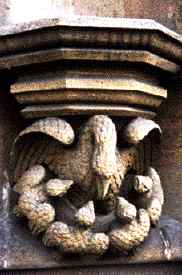Gothic art
Associated especially with the massive Gothic cathedrals of Europe, Gothic art was made possible both by the discovery of the pointed arch, which made higher and better lit buildings possible, and by the commitment of generations of craftsmen to the decoration of these buildings.
Anything structural could be made decorative, whether it could be seen or not. Water spouts, necessary for drainage, became gargoyles; the base of an arch, the corbel, became a small sculpture; the point where vaulting intersected became a golden boss; the underside of a seat was carved, and as in this illustration the support for a niche designed for a statue became a small sculpture of a pelican's brood*.
Click here to find out why the niche above the pelican is empty* in this picture, or click to see a sculpture of a gnome.
"The fairest parish church in England"
In 1574, on one of her popular progresses through the countryside of England, Queen Elizabeth remarked that Saint Mary Redcliffe, Bristol, was "the fairest, goodliest, and most famous parish church in England." Three years earlier, Elizabeth had given permission for the church to run a free grammar school for children of the parish; Shakespeare would have attended such a school in Stratford.
The church dates for the most part from the fourteenth century, and is a superb example of Gothic architecture.
Footnotes
-
Pelican = Christ?
The pelican figured here was an icon for the sacrifice of Christ, since the mother pelican was thought to feed its brood by pecking at its breast so they could feed on her blood. Such allegories were central in medieval bestiaries; click for a discussion of the change from bestiary to biology.
